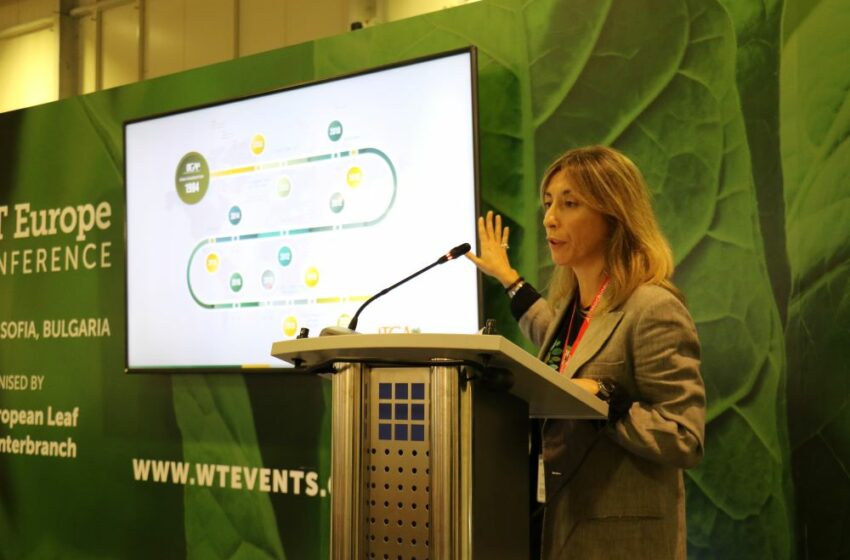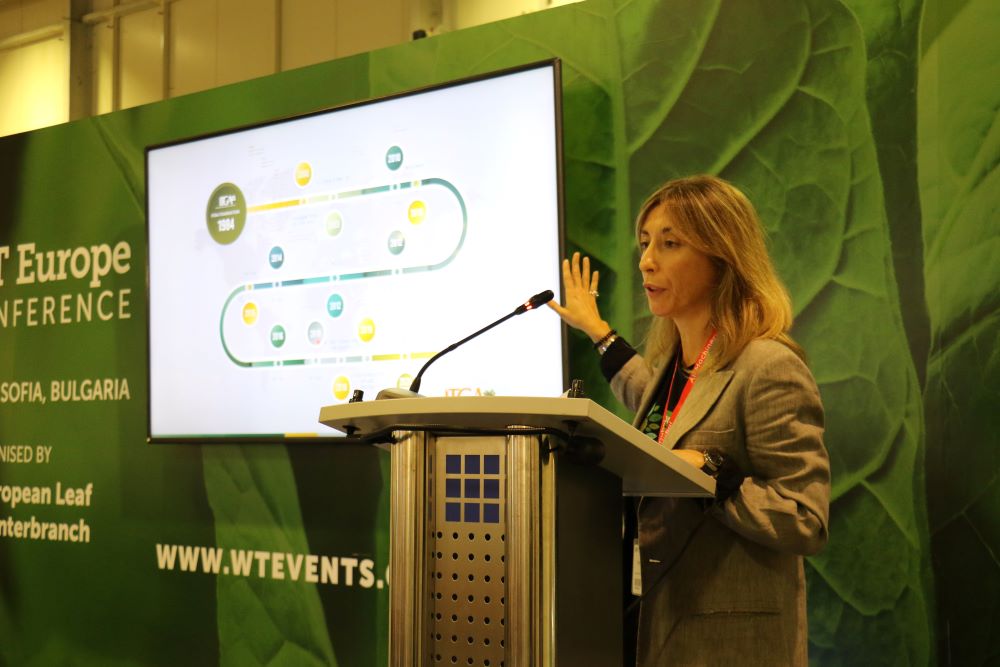Spreading the Risk
- Also in TR Print Edition
- October 1, 2023
- 0
- 12 minutes read

Mercedes Vazquez

Protecting farmer livelihoods as demand for leaf tobacco changes.
By George Gay
Somebody once observed that while nobody knows what comes next, everybody does it. This notion came to mind recently when I was asked to write a story about efforts being made to diversify tobacco farmers’ income streams as demand for leaf stagnates, a story that had to be based on predictions about what comes next in respect of demand for tobacco.
The question about future demand might seem simple to answer, but for every argument I came up with for a likely global demise of leaf demand, I was able to come up with another suggesting an increasing demand. It did not help that when I started my research, I came across stories about four producer countries on three continents that were aiming to increase their productions next season, though whether from high points or low points I could not be sure. I must admit, too, that next season is not the future, but neither can I ignore it. I am mindful of something the International Tobacco Growers’ Association’s Mercedes Vazquez told me: that the long term was nowadays no more than a year—a telling observation summing up the insecurity many tobacco growers live with daily, even as critical suppliers to a wealthy industry.
But, whatever happens, everybody will have to do what comes next and, as things stand, a lot of people seem to be betting leaf demand will stagnate and fall. So what is to be done? How can we protect, and hopefully even improve, the livelihoods of the millions of people and their families who currently produce tobacco and rely upon the income it earns, some of whom currently live in poverty? After all, it is easy to talk about global demand or lack of it, but many of the solutions will, of necessity, come down to the level of individual farmers. Certainly, my first impression from talking to people was that this is a devilishly difficult subject, partly because of its diversity. Tobacco comes in a variety of types and styles while its production is geographically widespread under a range of conditions, some of them changing, and subject to different government regulations. It is carried out by commercial farmers and smallholders, who are given varying amounts of support and who sell their tobacco either over auction floors or via contract arrangements, each of which is open to good or bad practices.
Seeking Alternatives
Notwithstanding this diversity, however, the overall impression I was given was that there was no need to panic, though, for various reasons not necessarily solely to do with falling demand, the urgency in certain countries is higher than that in others. If leaf demand is going to fall, it is not going to fall precipitously in most markets. But that is not to say there is room for complacency, especially in those countries where tobacco contributes substantially to their foreign exchange earnings.
On the other hand, perhaps there is reason to panic. Another impression I was given was that there are few, previously unexploited, viable options available to farmers who want to stay in business while quitting tobacco production substantially or completely. It is also the case that identifying viable alternatives takes time, investment, research, market development and the cooperation of a wide range of stakeholders, not all of them holding the same stakes.
It must be remembered that tobacco growers tend to be canny operators who didn’t come down with the last shower of rain. Many of them already largely know which other crops work on their land and which do not because, partly in order to preserve their soils in good condition, they practice crop rotation, and in order to supplement their incomes or help feed their families, they keep a weather eye out for what their neighbors are doing and what the various markets are telling them.
Of course, they can always use some help. And the greater the need for tobacco growers to expand the number of crops they grow or to diversify into other activities, the more important it is that such diversifications are coordinated, at least at the regional level, more likely at the national level, and perhaps internationally. If all the world’s tobacco growers suddenly switched to producing groundnuts, the market for this product would go, well, nuts. Admittedly, that is unlikely to happen because diversifications will be governed by local conditions such as weather, soils, farmer skills, established markets, the availability of inputs and irrigation water, regulations, etc. Nevertheless, there is a need for coordination through organizations and companies with skills in this area.
Long-Term Viability
One such company is Alliance One International, whose vice president of global agronomy, Helio Moura, had, in part, the following to say in an emailed response to questions. “At Alliance One, we are focused on the long-term viability of our business and the sustainability—in all aspects—of the farmers with whom we contract. Our company has an ESG [environmental, social and governance] target to improve 100 percent of our contracted farmers’ livelihoods through good agricultural practices and opportunities for crop diversification and have introduced a number of crops to our grower base, including but not limited to maize in South America and groundnuts in Africa.
“Agricultural production of any kind has challenges. Farmers today are navigating climate change, succession planning, inflation and more. The reality is, a large portion of tobacco growers are smallholder farmers, growing on 10 ha or less of land. They rely on their tobacco crop as their base or supplemental income, making tobacco a significant part of many of the economies in the countries where we operate.
“To promote positive outcomes for our growers, we implement a variety of measures, including research and development initiatives, ongoing grower education and strategic partnerships, to best position contracted farmers to cultivate high-quality, high-yield complementary crops ….”
Meanwhile, Paulo Saath, vice president of Global Supply Chain Leaf at Japan Tobacco International, which sources tobacco from 34 countries and collaborates with about 62,000 farmers, had this to say: “One of the most effective strategies to overcome the challenges rural communities face, primarily poverty, is agricultural development.
“JTI’s Agricultural Labor Practices program aims to enhance the work environment of farmers by creating fairer working conditions, improve their well-being as well as their families’ and help them generate stable tobacco revenue. In Malawi, where tobacco is one of the most profitable value chains, since we vertically integrated our operations in 2009, contracted farmers have seen their average yields increase by around 140 percent, from 800 kg per hectare to 1,950 kg [per hectare] in 2023.
“We have set out Minimum Agronomic Standards by which our contracted growers are encouraged to rotate tobacco with complementary crops such as maize, groundnuts, soya as well as livestock and [are] provided with seeds and fertilizers. This helps them supplement their tobacco income, guarantee food security, entrench Good Agricultural Practices by improving soil health, and build climate change resilience ….
“In Malawi, we have a team of agronomy technicians who routinely visit our directly contracted growers, providing technical advice on how to improve the tobacco yield and quality and also building farm management capabilities (including financial planning, agroforestry, soil management, and human and labor rights).”
Evidenced-Based Initiatives

One thing that strikes me about these comments is that while there is much emphasis on improving and diversifying income streams, there is no mention of a stagnation or decline in demand for tobacco. So is it really the case that such a stagnation or decline is happening or is on the horizon? Not perhaps if you talk to the Malawi Tobacco Commission, which earlier this year said it was hoping this season’s leaf prices would motivate growers to produce more tobacco during the next season.
More tobacco? Perhaps not a good idea, according to a report by the Foundation for a Smoke-Free World (FSFW), at least in the case of smallholder Malawian growers. This is what the FSFW had to say in the key takeaways section of its March 2022 Malawi Country Report: “Smallholder farmers occupy the lowest-valued component of the tobacco value chain. As the most vulnerable link in the value chain, farmers are frequently forced to grow tobacco at their own expense, literally and figuratively. Contract farming arrangements with major tobacco buyers often leave many smallholder farmers in poverty and some in perpetual debt. Their surrounding environment suffers as a result of deforestation and soil degradation. The collective impact of growing tobacco on the lived experiences of smallholder farmers and their families thus underscores the need to find alternative crops or livelihoods.”
I must say, however, that I was told by Candida Nakhumwa, vice president and Malawi country director of the FSFW, that the FSFW’s involvement in Malawi was also about addressing a decline in tobacco demand, which she put at 5 percent a year in respect of burley, the tobacco crop largely produced by the smallholder farmers with which the FSFW mainly interacts. Nakhumwa said that in Malawi, with a rural population of about 80 percent, addressing this decline had to be looked at as urgent. But, at the same time, it had to be looked at thoroughly, which, from what she told me, it is apparently doing, through a wide range of evidence-based initiatives.
The FSFW’s program concentrates on identifying alternative crops and researching their viability in an effort to diversify away from tobacco dependence. It supports farmers in increasing their productivity and production of nontobacco crops, which traditionally has been low, through the introduction of improved technologies in the form, for instance, of better seeds, plant nutrition, crop protection, irrigation and good agricultural practices.
The program also seeks to develop systems around new crops and activities that are supported by research and extension services and that have available structured and competitive markets. And this was not easy to achieve, Nakhumwa said, adding that, nevertheless, the FSFW had already made “tremendous progress.” Some farmers had totally transitioned away from tobacco to alternatives, such as groundnuts and soyabeans, and in doing so had increased their incomes, she said.
That is Malawi, of course, which has been fortunate in attracting the attention of the FSFW. Elsewhere, efforts are probably less structured.
Farmer Involvement
Nakhumwa emphasized time and again that all aspects of the FSFW’s wide-ranging research and efforts were centered on the farmers, who, after all, were the ones driving the economy. And it was farmer participation, or rather the lack of it, that was very much on the mind of Vazquez, who made the point that farmers were often left out of discussions around developments affecting their futures. What I took away from speaking and corresponding with Vazquez was that whereas the ITGA and farmers in general were willing to discuss tobacco growers transitioning out of tobacco, those advocating such moves had to be cognizant of the fact that, like it or not, tobacco often provided the best chance for farmers to support their families and wider communities. Given this, transitioning, unless carefully thought through, could be devastating. It had to be remembered that no crops or business activities were risk-free. No market was immune from exploitation by those intent on doing so.
Of course, there are any number of reasons why some growers and countries will continue to grow tobacco and some will not and why some will reduce production and some will not. For instance, there will be a move away from tobacco production because younger generations are often reluctant to take up farming. And there are the pending EU regulations that, from next year, will investigate supply chain issues, such as deforestation and child labor.
The ITGA says it supports balanced regulation aimed at maintaining good governance in supply chains and addressing social and environmental issues. But it points out that addressing these issues in relation to smallholder farmers means firstly tackling poverty, the root cause of these issues, with decent incomes. As was made clear at the most recent ITGA regional meeting, grower sustainability needs to start with grower viability.
In fact, I don’t think it’s unfair to ask why smallholder tobacco growers should live in poverty when they are stakeholders—and surely vital stakeholders—in a wealthy industry. That’s a rhetorical question, by the way.

